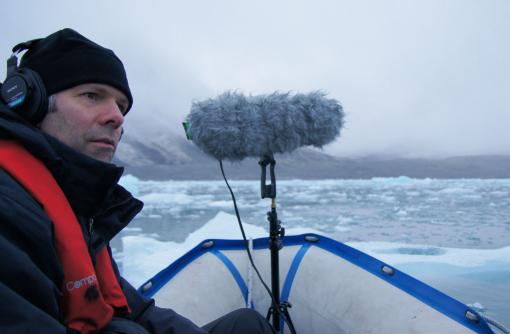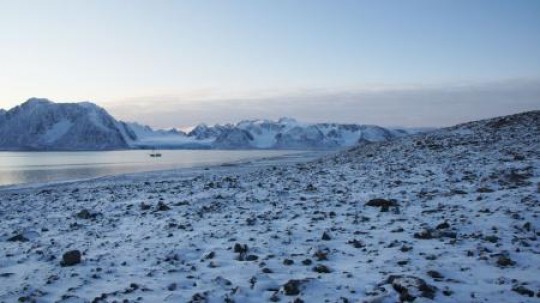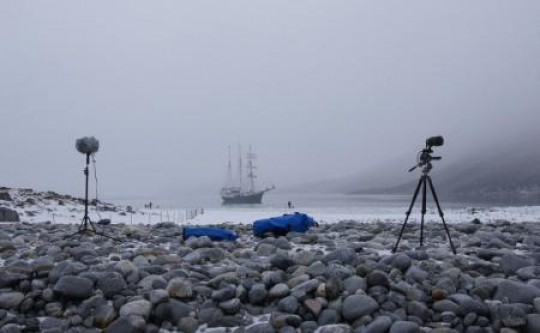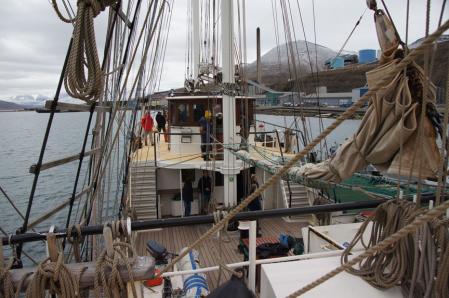Artists take on the Arctic
Artists take on the Arctic
Aboard an ice-class expedition sailing vessel, media artist Ed Osborn spent 18 days exploring and recording the sights and sounds of the high Arctic. He and 19 other artists, including filmmakers, photographers, and writers, had the opportunity to pursue personal projects and explore collaborations.
 Sounds of silence
Sounds of silence
A Zodiac took Osborn and other artists from ship to shore, where they spread out to work individually, recording, shooting photography, or staging conceptual works until it was time to return to the ship. Credit: All images by Ed Osborn
How’s this for a combination? Twenty international artists. Eighteen days. One ship. Occasional polar bears.
This fall, media artist Ed Osborn journeyed into the high Arctic as part of the Arctic Circle, an expeditionary residency program that annually takes artists of all disciplines to the Svalbard archipelago, just 10 degrees from the North Pole. On board an ice-class expedition sailing vessel, he and 19 other artists, including filmmakers, photographers, and writers, had the opportunity to pursue personal projects while also exploring collaborations. According to the organizers, the program is “a nexus where art intersects science, architecture, and activism — an incubator for thought and experimentation for artists and innovators who seek out and foster areas of collaboration to engage in the central issues of our time.” For Osborn, it was a longtime dream, finally realized.
 Crisp colors, changing light, near silence
Crisp colors, changing light, near silence
Osborn called his side trip to a lake near Raudfjord a highlight of his trip — “the quietest place I’ve ever been.”
“I’ve been interested in polar regions for a long time,” said Osborn, assistant professor of visual art, who works in a variety of electronic media. “I’ve wanted to go to Antarctica, but that’s pretty difficult to arrange in a way that would work for my creative practice, so when I heard about the Arctic Circle program, I was excited to have the latitude to do something special and have access to some similar polar landscapes that I would in the south.”
Day after day, the ship stopped at planned destinations like abandoned coal mines and massive glaciers. After armed guards scoped out the sites for polar bears, a zodiac boat transported the group and their gear through the icy waters from the schooner to rocky shore. (The group only saw the bears from afar during their trip, along with reindeer, walruses, seals, and arctic foxes, but they saw plenty of paw prints up-close). Once on solid ground, the artists spread out to work individually, recording, shooting photography, or staging conceptual works, among other things, until it was time to return to the ship. The group came together every evening in the common area for meals, conversation, and presentations.
The glacial landscape was “spectacular” and “amazingly clear,” with crisp colors and ever-changing light. And often, their surroundings were nearly silent. In fact, Osborn called his side trip to a lake near Raudfjord a highlight of his trip, “the quietest place I’ve ever been.”
 Naturally minimalist
Naturally minimalist
“There are very few basic elements … snow, water, ice, rocks, and some wildlife. That’s pretty much it.” Still, there were sounds even underwater.
But the silence didn’t stop Osborn from recording hours of sounds — water, waves, and ice, and ambient noise including footsteps and voices from other travelers. He even lowered a pair of hydrophones four meters into the sea to collect underwater recordings. “It’s like dropping a mic inside a glass of soda, because there’s all this air that’s escaping and moving around in the ice. … It’s actually quite noisy,” he said.
He also shot plenty of video. Similar to previous work, Osborn reduces materials to be as minimal as possible – a style that worked well with these Arctic surroundings. “There are very few basic elements there — snow, water, ice, rocks, and some wildlife. That’s pretty much it,” he said. He reduced the landscape even further by shooting much of his video in infrared, a part of the light spectrum not visible to the naked eye, resulting in highly textured, gray-toned pans of the scenery. It was Osborn’s way to convey what he saw in way that’s different from traditional forms of landscape photography.
“It was the kind of landscape that rewards my approach to videos, which tends to be long still shots,” he said. “So there was a lot of space to do exactly that.”
While viewing some of his infrared material, Osborn pointed to a bold black line running through the shot, separating the water from shore. He explained: “See, the fact that this is a natural artifact of the process and not something added in post-production, is really interesting. … It’s real light that you can’t normally see. It’s real video of space that you can see, but usually not in this way. And it’s real space, that you rarely get a chance to see.”
Inspired by a story he heard about a series of lost radio reports that writer Arthur Koestler filed from a Zeppelin flight over the high Arctic in 1931, Osborn participated in the Arctic Circle program with a goal in mind: He wanted to “re-imagine the broadcasts, the extended narrative and engagement with a place.”
 Home for 18 days
Home for 18 days
“The trip provided a huge amount of material to work with. … No one really knows where it will take us, but we are all glad we went.”
“There aren’t any existing recordings of the broadcasts, if any recordings were even made,” Osborn said. “But the accounts of these broadcasts say that Koestler managed to provide long and engaging descriptions of the landscape which offered a very limited amount of material to describe, and that technique points to creative space to investigate and work with. So I wanted to think about ways to convey the experience of the Arctic terrain in ways that are elliptical and that don’t rely on traditional narrative or even traditional pictorial narrative.”
Osborn’s experience will be shared: He plans to use his recordings to create a sound installation, a two-channel sound work, and a multichannel video installation. “The trip provided a huge amount of material to work with. I can produce a number of pieces and be able to extend it in many different ways. The form and direction of some of these pieces seem clear already, others will take quite a while to sort out. A number of the other artists on the voyage also said that it would take some time to process the experience and generate work out of it. No one really knows where it will take us but we are all glad we went.”
###
* The above story is adapted from materials provided by Brown University
** More information at Brown University (Providence, Rhode Island, USA)




















